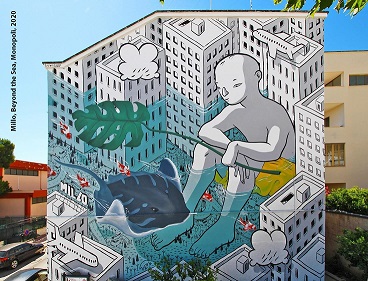Confronting Marginality: human and nonhuman resilience in the landscape of disaster
DOI:
https://doi.org/10.54103/2035-7680/18681Parole chiave:
nuclear disaster; environmental literature; liminality; women’s writing; Japanese literature; environmental traumaAbstract
The March 2011 Tōhoku triple disaster reinforced an already liminal space inside Japan. The region of Tōhoku, historically considered at the margins, was once again framed as a marginal space separated from the Japanese ‘centre’. However, the physical area of the disaster acquired new figurative dimensions allowing for an artistic and cultural response to the events of March 2011 and to the national narrative of fast recovery. In the novel In the Zone (2016) by Taguchi Randy, the abandoned and marginal landscape of the exclusion zone assumes the characteristics of a space for survival and renovation. The human and nonhuman characters challenge their social and physical marginality through the continuous movement in the exclusion zone and across several physical and figurative boundaries. Furthermore, in this liminal space, bodily acts—such as laughing, dancing, or singing—become a way to build resilience and recover from previous traumas. This paper concludes that the novel In the Zone constructs the disaster as a positive trope engendering recovery from past traumas and confronting national discourses on the environment, women, and marginal communities.
Metriche
Riferimenti bibliografici
Alexander, Jeffrey C. “Toward a theory of cultural trauma.” Cultural trauma and Collective Identity, edited by Jeffrey C. Alexander et al., U of California P, 2004, pp. 1-30.
Caruth, Cathy. Unclaimed Experience: Trauma, Narrative and History. Johns Hopkins UP, 1996.
DiNitto, Rachel. “Literature maps disaster. The contending narratives of 3.11 fiction.” Fukushima and the Arts: Negotiating Nuclear Disaster, edited by Barbara Geilhorn and Kristina Iwata-Weickgenannt, Taylor & Francis Group, 2016, pp. 21-38.
---. Fukushima Fiction: The Literary Landscape of Japan’s Triple Disaster. U of Hawaii P, 2019. doi.org/10.1515/9780824879457. Accessed 17 Jun. 2022.
Enarson, Elaine Pitt. Women Confronting Natural Disaster: From Vulnerability to Resilience. Lynne Rienner Publishers, 2012.
Geilhorn, Barbara, and Kristina Iwata-Weickgenannt, editors. Fukushima and the Arts: Negotiating Nuclear Disaster. Taylor & Francis Group, 2016.
Gunderson, Lance H. “Ecological Resilience—In Theory and Application.” Annual Review of Ecology and Systematics, vol. 31, 2000, pp. 425-439.
Hara, Takuji. “Social Shaping of Nuclear Safety Before and After the Disaster.” Nuclear Disaster at Fukushima Daiichi: Social, Political and Environmental Issues, edited by Richard Hindmarsh, Routledge, 2013, pp. 22-40.
Harada, Kazue. “Visible Matters; Radiation in Kobayashi Erika’s Multimedia Project in Post-Fukushima Japan.” Japanese Studies, vol. 41, no. 1, Jan. 2021, pp. 1-21. doi.org/10.1080/10371397.2020.1847637. Accessed 17 Jun. 2022.
Lake, Philip S. “Resistance, Resilience and Restoration.” Ecological Management & Restoration, vol. 14, no. 1, 2013, pp. 20-24. doi.org/10.1111/emr.12016. Accessed 17 Jun. 2022.
Lamb, Nicole, and Gerhard Hoffstaedter. “’We Walk, We Laugh, We Dance’: Refugee Experiences of Older Chin Women in Kuala Lumpur.” Ageing & Society, vol. 40, no. 5, May 2020, pp. 1021-38. doi.org/10.1017/S0144686X18001502. Accessed 1 Jun. 2022.
Luft, Rachel E. “Racialized Disaster Patriarchy: An Intersectional Model for Understanding Disaster Ten Years after Hurricane Katrina.” Feminist Formations, vol. 28, no. 2, Summer 2016, pp. 1-26.
Yuki, Masami. Foodscapes of Contemporary Japanese Women Writers. An Ecocritical Journey around the Heart of Modernity. Translated by Michael Berman, Palgrave Macmillan, 2015.
Pailer, Gaby, et al., editors. Gender and Laughter: Comic Affirmation and Subversion in Traditional and Modern Media. Brill, 2009.
Pastor, Doreen, and Alexander J. Kent. “Transformative Landscapes: Liminality and Visitors’ Emotional Experiences at German Memorial Sites.” Tourism Geographies, vol. 22, no. 2, Mar. 2020, pp. 250-72. doi.org/10.1080/14616688.2020.1725617. Accessed 1 Jun. 2022.
Taguchi, Randy. Zon ni ite [“In the Zone”]. Kindle edition, Bungeishunju, 2016.
Vinci, Tony M. Ghost, Android, Animal: Trauma and Literature Beyond the Human. Routledge, 2019. doi.org/10.4324/9780429291623. Accessed 17 Jun. 2022.
Wiig Siri, and Babette Fahlbruch editors. Exploring Resilience: A Scientific Journey from Practice to Theory. Springer Nature, 2019. library.oapen.org/handle/20.500.12657/23081. Accessed 17 Jun. 2022.
Willig, Carla, and Luisa Wirth. “Liminality as a Dimension of the Experience of Living with Terminal Cancer.” Palliative & Supportive Care, vol. 17, no. 3, Jun. 2019, pp. 333-37. doi.org/10.1017/S1478951518000536. Accessed 17 Jun. 2022.
Dowloads
Pubblicato
Come citare
Fascicolo
Sezione
Licenza

Questo articolo è soggetto a licenza Creative Commons Attribution-NonCommercial-NoDerivatives 3.0 International License.




